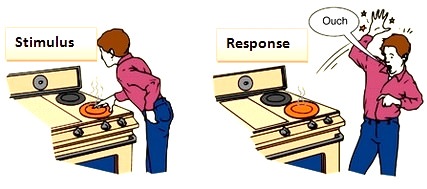Reflex action is a sudden and involuntary response of effectors (muscles and organs) to a stimulus. Withdrawl of hands when touched by hot things, watering of mouth on seeing favourite food, coughing, sneezing and blinking of eyes are examples of reflex actions. The reflex actions are controlled both by brain and spinal cord. The reflex actions which are controlled by brain are called cerebral reflex actions. And the reflex actions which are controlled by spinal cord are called spinal reflex actions.
 The path traveled by a nerve impulse from the region of stimulation to the region of response is called reflex arc. It involves following five structures:
The path traveled by a nerve impulse from the region of stimulation to the region of response is called reflex arc. It involves following five structures:
1. Receptors
2. Sensory nerves
3. Brain or spinal cord
4. Motor nerves and
5. Effectors.
To understand reflex arc more clearly, let’s take an example. When we suddenly touch a hot plate, we pull our hands away from hot plate very quickly and without thinking. Here, following things happen: the skin of our hands (receptors) feels the hotness of plate and sends a nerve impulse to the spinal cord through sensory nerves. The spinal cord interprets the message and decides what the response should be. Then a nerve impulse is sent by spinal cord to the muscles (effectors) in arm through motor nerves. The muscles receive the message and contracts to pull hand away from the hot plate. This pathway of reflex action can be shown as given below:

Test Your Understanding and Answer These Questions:
- Explain reflex action and reflex arc.
- Define reflex action with suitable examples.
- Arrange the following in correct order: Receptors, muscular activity, spinal cord, motor nerve, sensory nerve.
